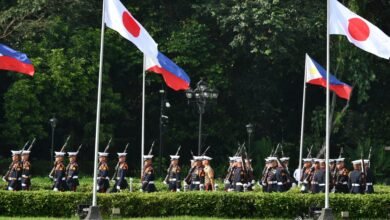There is now a window of opportunity for peace in Syria | Opinions

On November 27, merely hours after a ceasefire agreement between Israel and Lebanon came into effect, a coalition of Syrian opposition factions launched their biggest military operation in years. Led by Hayat Tahrir al-Sham (HTS), they attacked positions of the Syrian regime in Aleppo province, quickly advancing as their opponents retreated.
Within days, they managed to gain control of Syria’s second-largest city Aleppo and the entire Idlib governorate, reaching the outskirts of Hama.
This unexpected campaign by the Syrian opposition has rekindled a conflict that was long considered “frozen”. It has also shattered the perception that Syrian leader Bashar al-Assad has achieved victory and may pave the way for renewed peace negotiations.
Why the opposition succeeded
For nearly 10 years, a coalition of Russian forces, Hezbollah, and Iran-linked groups have helped al-Assad retain control of most of Syria, with the exception of the north.
Over the past two years, this coalition has been degraded due to a series of developments, including the Russian invasion of Ukraine in February 2022 and this year’s Israeli war on Lebanon.
In 2023, after the rebellion of mercenary leader Yevgeny Prigozhin and his subsequent death, Russia ordered his Wagner Group forces, which had played a critical role in ground battles, to leave Syria. This year, Moscow was forced to pull some of its air force units back from Syria which had long provided much-needed air cover for the Syrian regime forces. The fleet of Russian aircraft currently stationed at the Hmeimim base in Latakia has dwindled compared with its peak strength before the onset of the Ukraine war.
Hezbollah forces deployed in Syria have also declined. The war with Israel inflicted heavy losses on the group, as many of its upper echelons and its leader, Hassan Nasrallah, were killed. As a result, the group has had to withdraw a good part of its forces deployed in the Aleppo and Idlib countryside towards Lebanon. Iran’s military presence in Syria has also been weakened by frequent Israeli attacks.
The Syrian regime forces have also been degraded over the past 14 years of war. Defection and combat losses have dwindled significantly, while the financial crisis has limited Damascus’s ability to pay regular wages.
When the opposition launched its attack, it faced a completely worn-out army that had lost the will to fight. Morale had collapsed, especially with the absence of allies on the ground and the Russian Air Force in the sky; they retreated quickly.
By contrast, the opposition’s performance has improved significantly in recent years, as it has become better organised and more disciplined, especially HTS. It has also been better equipped as a result of local manufacturing, seizing weapons from the regime’s positions and its allies, and obtaining them from external parties.
There is now an opportunity for peace
The Syrian opposition’s advance was surprising to many probably because for years, al-Assad has been acting as a victor in the Syrian civil war. Since his forces regained control over large parts of the country in 2018, including the three de-escalation zones in the south, Damascus countryside and northern Homs, it has refused to make any concessions or even engage in any serious negotiations – whether through the United Nations-sponsored Geneva process or the Russian-sponsored Astana process.
Normalisation of relations with Arab countries also boosted al-Assad’s self-confidence. Just last year, he was invited to attend the Arab Summit in Riyadh which ended 12 years of Arab isolation. All of this had convinced the regime that it could regain its membership and legitimacy in the community of nations and secure economic aid for reconstruction without having to make any concessions, neither to the Arab countries nor to the Syrian opposition.
In addition, believing that he has the upper hand, al-Assad turned down several offers by Turkiye to resolve the Syrian refugee problem and move the political process forward.
The rapid advance of the opposition has shattered the illusions of victory that the regime and its allies have cradled. The opposition now controls most of northern Syria, including Aleppo, home to about one-fifth of the Syrian population. With its economic, industrial, human and political weight, Aleppo could become a pivotal point for the Syrian opposition and a major asset in any potential negotiations.
The situation on the battleground also reflects new geopolitical realities. Al-Assad’s main allies, Iran and Russia, have been losing influence due to regional and international conditions, whereas Turkiye, the main regional ally of the opposition, is on the rise.
As a result, there is now a window of opportunity to launch a genuine political process that could end the 14-year-old conflict, which has left hundreds of thousands of Syrians dead, millions displaced and the country in tatters.
As things stand now, Russia and Iran lack the troops and firepower to reverse the tide. To save al-Assad this time around, they have no alternative but to commit themselves to a political process.
The incoming US administration may also encourage this. Although previously, US President Donald Trump turned away from Syria, describing it as a land of “sand and death” and ordering the withdrawal of US troops in the Kurdish-held northeast, this time around, the Syrian war may present him with an opportunity for a quick foreign policy success and making good on his promise to “end wars”.
Syria is low-hanging fruit, and Iran and Russia may be eager to strike a deal with Trump. Succeeding where his Democratic predecessors failed may be a good enough incentive for the new US president to put his weight behind the negotiation of a peace agreement.
The views expressed in this article are the author’s own and do not necessarily reflect Al Jazeera’s editorial stance.
Source link



